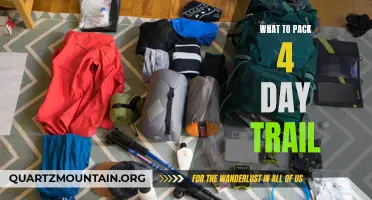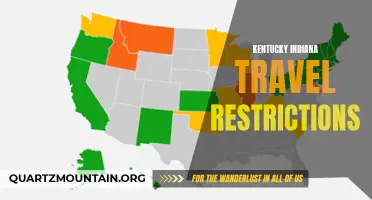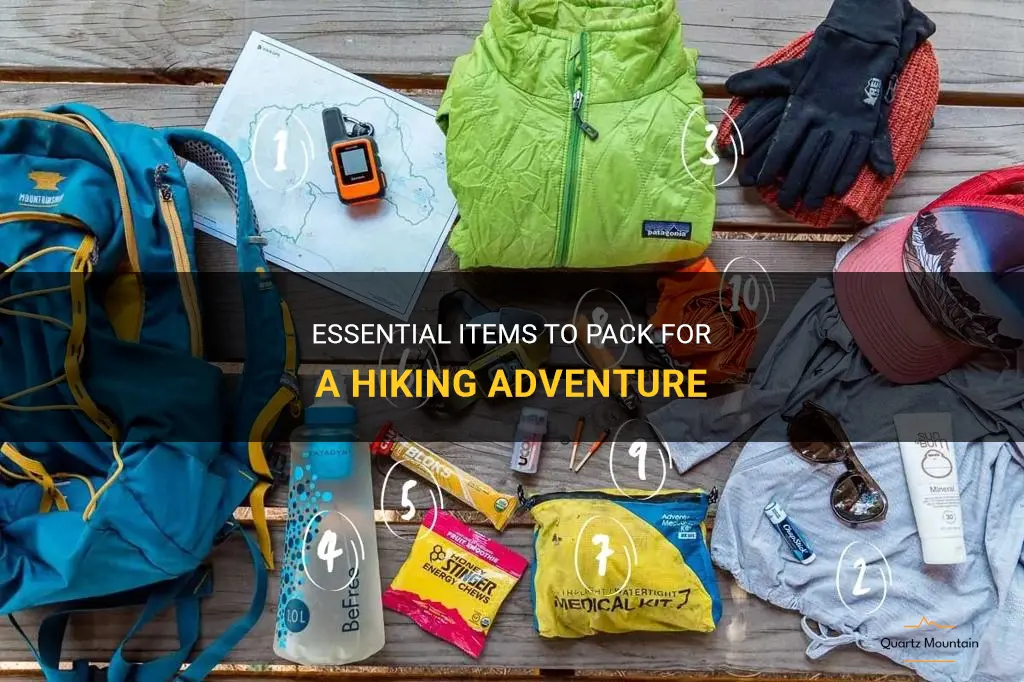
If you're planning a hiking adventure, packing the right essentials is crucial for a successful and enjoyable trip. From sturdy footwear to weather-appropriate clothing, your packing list can make all the difference. Whether you're a seasoned hiker looking for a refresher or a beginner seeking guidance, this guide will ensure you have everything you need to tackle the trails with confidence. So grab your backpack and get ready to explore the great outdoors!
| Characteristics | Values |
|---|---|
| Water | Yes |
| Food | Yes |
| Backpack | Yes |
| Comfortable shoes | Yes |
| Map and compass | Yes |
| First aid kit | Yes |
| Weather-appropriate clothing | Yes |
| Sun protection | Yes |
| Emergency shelter | Yes |
| Extra clothing | Yes |
| Headlamp | Yes |
| Knife or multi-tool | Yes |
| Fire starter | Yes |
| Whistle | Yes |
| Cell phone | Yes |
What You'll Learn
- What are the essential items to pack for a day hike?
- How should I pack my backpack for a multi-day hiking trip?
- Are there any specific clothing items or gear that I should pack for different types of hiking terrain or weather conditions?
- What type of food and hydration should I pack for a long hike?
- Are there any additional safety items or emergency supplies that I should include in my hiking gear?

What are the essential items to pack for a day hike?
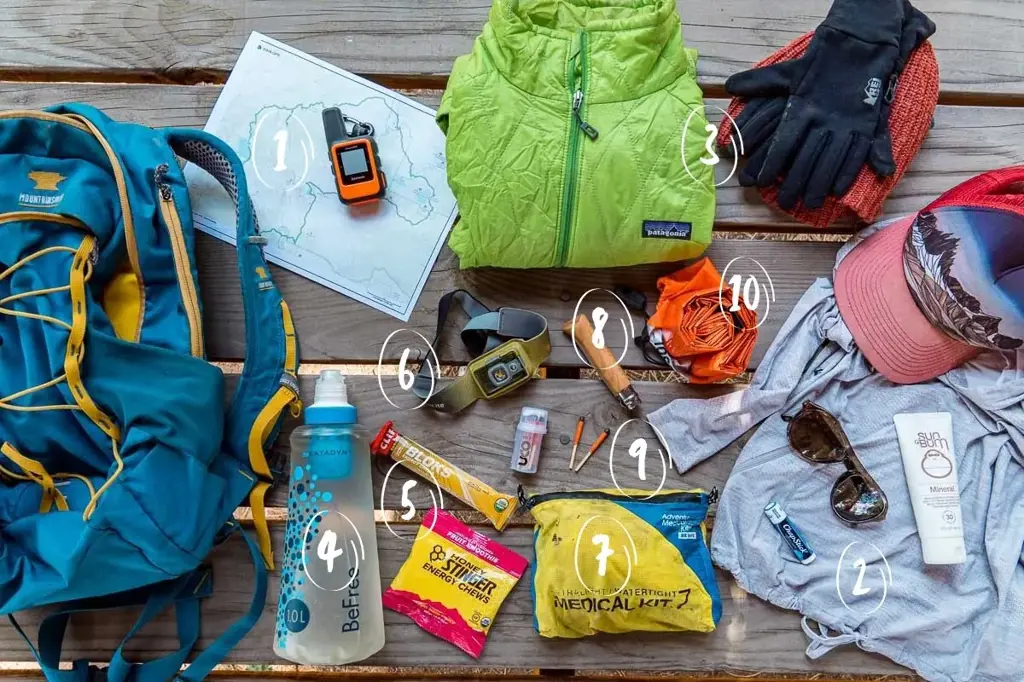
When going on a day hike, it is important to pack the necessary items to ensure a safe and enjoyable trip. Whether you are a beginner or an experienced hiker, here is a list of essential items that you should pack for a day hike.
- Water: Staying hydrated is crucial during a hike, especially if it is a hot day or if you are exerting yourself. It is recommended to carry at least two liters of water per person. You can use a hydration bladder or water bottles to carry your water.
- Food: Pack enough snacks and meals to keep you energized throughout the hike. Choose lightweight and easy-to-carry food items such as energy bars, trail mix, sandwiches, or fruits. Keep in mind that hiking burns a lot of calories, so it is important to fuel your body adequately.
- Navigation tools: It is essential to have a map, compass, or a GPS device to help you navigate the trail. Familiarize yourself with the route before your hike and have a backup navigation method in case your primary one fails. This will ensure that you stay on the right path and avoid getting lost.
- First Aid Kit: Accidents can happen during a hike, so it is important to carry a basic first aid kit. Include items like band-aids, antiseptic wipes, blister pads, pain relievers, and any necessary prescription medications. Make sure to also pack any personal items you may need, such as an EpiPen if you have allergies.
- Sun protection: Protect your skin from the sun's harmful rays by wearing sunscreen with a high SPF. Additionally, wear a wide-brimmed hat, sunglasses, and lightweight, breathable clothing to shield yourself from the sun. Sunburn can be a serious problem, especially at higher altitudes where the sun’s rays are stronger.
- Extra clothing: Weather conditions can change unexpectedly during a hike, so it is important to pack extra clothing layers. Carry a lightweight, waterproof jacket, a hat, and gloves to protect yourself from rain, wind, or cold temperatures. It is better to overpack in terms of clothing than to be caught unprepared.
- Proper footwear: Investing in a good pair of hiking shoes or boots is essential for a comfortable and safe hike. Choose footwear that provides ankle support, has a good grip on various terrains, and is waterproof. Avoid wearing new shoes on a hike, as they can cause blisters and discomfort.
- Communication device: In case of an emergency or if you get lost, it is important to have a reliable communication device. Carry a fully charged cell phone or a two-way radio to contact emergency services or to stay in touch with fellow hikers.
- Multi-tool and other essentials: A multi-tool, such as a Swiss Army knife, can come in handy during a hike. It can be used for various purposes, including cutting, opening cans, or fixing gear. Additionally, pack other essentials such as a flashlight, extra batteries, a whistle, and a lightweight backpack to carry all your items comfortably.
- Personal items: Don't forget to pack personal items such as a camera, binoculars, a notepad, and a pen to document your hike or to observe wildlife. These items can enhance your overall hiking experience.
Remember, the key to a successful day hike is to pack efficiently and keep your backpack as lightweight as possible. It is important to prioritize safety and comfort while also considering the duration and difficulty level of your hike. By packing these essential items, you will be well-prepared for a day hike and can fully enjoy the beauty of nature.
Essential Items to Pack for a Memorable Weekend in the Cotswolds
You may want to see also

How should I pack my backpack for a multi-day hiking trip?
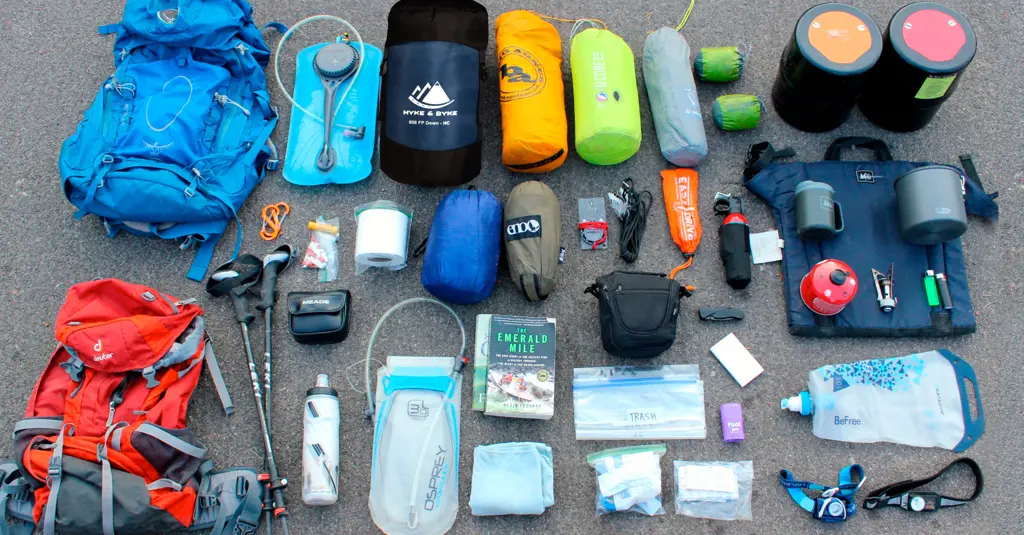
When preparing for a multi-day hiking trip, one of the most important things to consider is how to pack your backpack efficiently and effectively. Packing your backpack properly can help ensure that you have everything you need while also distributing the weight evenly for a comfortable hiking experience. Here are some tips on how to pack your backpack for a multi-day hiking trip.
- Choose the right backpack: Before you start packing, make sure you have a backpack that is suitable for multi-day hiking trips. Look for a backpack that is lightweight, has a comfortable harness system, and offers sufficient storage space. Consider the capacity of the backpack based on the duration of your hike and the amount of gear you will be carrying.
- Organize your gear: Before you start packing your backpack, make a checklist of all the essential items you will need for your multi-day hike. Categorize your gear into different groups such as shelter, clothing, food, cooking equipment, and personal items. This will help you pack efficiently and ensure that you have everything you need.
- Use dry sacks or compression bags: To keep your gear organized and protected from water, use dry sacks or compression bags for items such as clothing, sleeping bags, and food. These sacks are usually made of waterproof materials and can help save space by compressing your gear.
- Pack in layers: When packing your backpack, it is important to consider weight distribution. Place heavier items closer to your back and higher up in the backpack to maintain balance. Start with a bottom layer of heavier items such as your tent, sleeping bag, and cooking equipment. Then, add a middle layer of lighter items such as clothing and personal items. Finally, place the lightest items, such as snacks and water, on top.
- Make use of pockets and compartments: Most backpacks come with various pockets and compartments. Utilize these spaces to store smaller items such as maps, compasses, first aid kits, and extra batteries. This will make it easier to access these items when needed and keep them organized.
- Keep frequently used items easily accessible: Items that you may need frequently, such as a water bottle, snacks, or a rain jacket, should be easily accessible. Place these items in the side pockets or top pockets of your backpack, so you don't have to dig through your gear to find them.
- Adjust the straps and harness: Once your backpack is packed, adjust the straps and harness to ensure a comfortable fit. The shoulder straps should be snug but not too tight, and the waist belt should sit comfortably on your hips. Make adjustments as necessary to distribute the weight evenly and avoid any discomfort or strain.
By following these tips, you can pack your backpack efficiently and ensure that you have everything you need for a multi-day hiking trip. Remember to consider the weight distribution, keep frequently used items easily accessible, and use dry sacks or compression bags to protect your gear. With a properly packed backpack, you can enjoy your hiking trip to the fullest.
Essential Items to Pack for a 2-Week 70s-Themed Vacation
You may want to see also

Are there any specific clothing items or gear that I should pack for different types of hiking terrain or weather conditions?
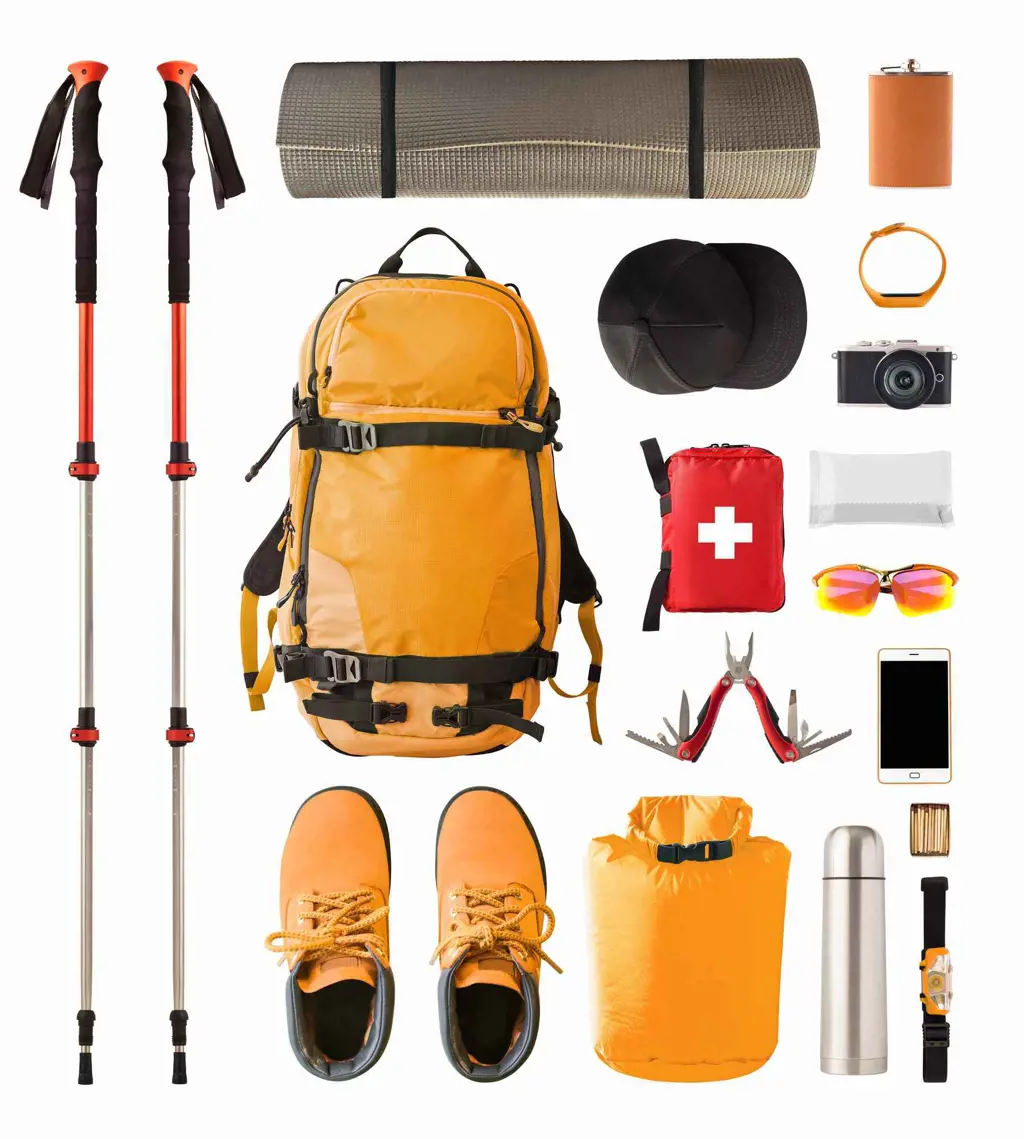
When it comes to hiking, it's important to be prepared for the terrain and weather conditions you'll encounter. The right clothing and gear can make a significant difference in your comfort, safety, and enjoyment of the hike. Here are some specific clothing items and gear that you should consider packing for different types of hiking terrain or weather conditions.
Hiking in Hot and Dry Conditions:
A. Lightweight and breathable clothing: Opt for moisture-wicking and quick-drying fabrics such as nylon or polyester to keep cool and prevent sweat from lingering on your skin.
B. Sun protection: Pack a wide-brimmed hat, sunglasses, and apply sunscreen generously to protect your skin from harmful UV rays.
C. Hydration gear: Carry a lightweight and durable water bottle or hydration pack to stay hydrated in the dry climate.
Hiking in Cold and Snowy Conditions:
A. Layered clothing: Wear a base layer made of moisture-wicking fabric, an insulating layer for warmth, and a waterproof and breathable outer shell to protect against wind and snow.
B. Insulated and waterproof footwear: Invest in insulated hiking boots with good traction to keep your feet warm and dry. Gaiters can also be useful to prevent snow from entering your boots.
C. Hand and head protection: Pack insulated gloves or mittens and a warm hat that covers your ears to protect against frostbite.
Hiking in Rainy and Wet Conditions:
A. Waterproof clothing: Choose a waterproof and breathable rain jacket and pants to keep yourself dry in wet conditions. Look for materials like Gore-Tex or eVent for optimum performance.
B. Waterproof footwear: Wear waterproof hiking boots or trail shoes with a good tread for traction on slippery surfaces.
C. Extra dry clothes: Pack an extra pair of dry socks, a change of clothes, and a pack cover to keep your gear dry in case of heavy rainfall.
Hiking in Mountainous Terrain:
A. Sturdy and supportive footwear: Opt for hiking boots with ankle support and a rugged tread to provide stability on uneven and rocky terrain.
B. Trekking poles: Use trekking poles to reduce strain on your knees and improve balance while ascending or descending steep slopes.
C. Layered clothing: Dress in layers to regulate your body temperature, as mountainous terrain can have large temperature variations between valleys and peaks.
Hiking in Forested Areas:
A. Insect protection: Wear long-sleeved shirts, long pants, and use insect repellent to protect against ticks, mosquitoes, and other bugs.
B. Lightweight and breathable clothing: Choose fabrics that are comfortable and breathable, as forested areas tend to be more humid and can trap moisture.
C. Navigation and signaling gear: Bring a compass, map, whistle, and a signaling mirror to help you navigate through dense forests and attract attention if needed.
Remember to always check the weather forecast and trail conditions before heading out on a hike. It's also essential to research the specific requirements and recommendations for the hiking trail you plan to explore. By packing the right clothing items and gear for the terrain and weather conditions, you'll be better prepared for a successful and enjoyable hiking experience.
Essential Items to Pack for a Trip to Colombia in August
You may want to see also

What type of food and hydration should I pack for a long hike?

When going on a long hike, it is crucial to pack the right type of food and hydration to keep your body nourished and energized. The food you bring should be lightweight, compact, and nutrient-dense to provide you with the necessary sustenance for your trek. Similarly, your hydration should be easily accessible and replenish electrolytes lost through sweat. In this article, we will discuss the types of food and hydration you should pack for a long hike, as well as some tips to ensure you have a successful and enjoyable trek.
One of the first things to consider when packing food for your hike is its weight. Since you'll be carrying your supplies on your back, it's important to choose lightweight options that won't add unnecessary pounds to your load. Dehydrated meals, energy bars, and nuts are all great examples of lightweight food options that are also rich in nutrients. These foods are easily portable, have a long shelf life, and can be prepared quickly with minimal cooking equipment.
Additionally, it's important to choose foods that are calorie-dense to provide you with the energy you need to tackle long hikes. Foods such as granola, dried fruits, nut butters, and trail mix are all excellent sources of calories and provide a good balance of carbohydrates, fats, and proteins. These foods will keep you fueled and satisfied throughout your hike.
When it comes to hydration, water is undoubtedly the most important component. It is essential to pack enough water for your entire hike, and if you'll be hiking in remote areas, it might also be wise to consider water purification methods such as water filters or purification tablets. However, it's not just water that needs to be replenished during a long hike. When you sweat, your body loses electrolytes such as sodium, potassium, and calcium. It is crucial to replace these minerals to prevent dehydration and maintain proper bodily function. Electrolyte supplements or sports drinks can be valuable additions to ensure you're getting the necessary electrolyte replenishment during your hike.
In addition to the type of food and hydration you pack, it's also important to consider the frequency of your meals and snacks. Rather than having three large meals, it is recommended to have smaller, frequent meals throughout the day. This approach will prevent you from feeling overly full or lethargic and will help maintain a steady flow of energy.
Moreover, it's essential to listen to your body and pay attention to any specific dietary needs or restrictions you may have. If you follow a specific diet, such as vegan, gluten-free, or dairy-free, make sure to pack food that aligns with your needs. This will ensure you have a pleasant and worry-free hiking experience.
Lastly, proper storage of your food is crucial to prevent spoilage and maintain freshness. Invest in sealable bags or containers to keep your food protected from moisture, odors, and pests. Storing food properly will not only ensure its longevity but also maintain its taste and quality.
In conclusion, when planning for a long hike, it is essential to pack the right type of food and hydration. Lightweight, nutrient-dense foods such as dehydrated meals, energy bars, and nuts are excellent choices. It's important to consider calorie-dense options and opt for smaller, frequent meals throughout the day. Hydration should primarily consist of water, with additional electrolyte replenishment through supplements or sports drinks. Lastly, proper storage and consideration of dietary restrictions are crucial for a successful and enjoyable hiking experience. By following these tips, you can ensure you have the fuel and nourishment needed to conquer your long hike with ease.
Essential Items for a Well-Prepared Girl's Emergency Kit
You may want to see also

Are there any additional safety items or emergency supplies that I should include in my hiking gear?
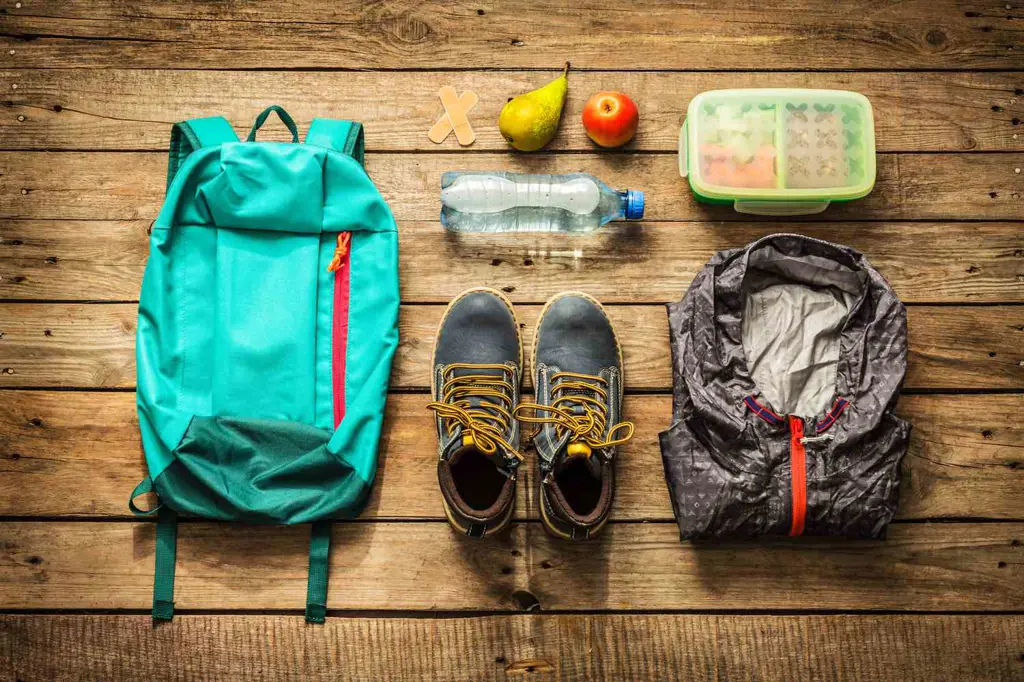
When it comes to hiking, it's essential to be prepared for any situation that may arise. While a well-packed backpack with essential items is crucial, there are also additional safety items and emergency supplies that you should consider including in your hiking gear. These items can provide you with extra protection and help you handle unexpected situations while out on the trail.
Here are some additional safety items and emergency supplies that you should consider including in your hiking gear:
- First Aid Kit: A well-stocked first aid kit is a must for any hike. It should include bandages, wound dressings, antiseptic ointment, pain relievers, tweezers, and other essentials. Be sure to customize your first aid kit based on your specific needs and any pre-existing medical conditions you may have.
- Emergency Whistle: An emergency whistle is a lightweight and easy-to-carry tool that can help you attract attention in case of an emergency. It can be used to signal for help if you get lost or injured on the trail.
- Fire Starter: Having a fire starter in your hiking gear can be a lifesaver in case you need to stay warm, cook food, or signal for help. Options can range from waterproof matches to fire starters that create sparks or flames.
- Emergency Shelter: Carrying a lightweight emergency shelter such as a space blanket or bivy sack can provide you with protection from the elements if you become stranded or lost. These shelters are compact and can help retain body heat, keeping you warm and safe.
- GPS Device or Compass: While many hikers rely on their smartphones for navigation, it's crucial to have a backup plan in case your phone battery dies or you lose signal. Carrying a GPS device or compass can help ensure that you stay on the right track and find your way back to safety.
- Extra Food and Water: It's always a good idea to carry extra food and water in case your hike takes longer than expected or you encounter unexpected delays. Energy bars, dried fruits, and nuts are lightweight and provide a quick source of energy. Additionally, carrying a water filter or purification tablets can help you access safe drinking water from natural sources if you run out.
- Multi-Tool: A multi-tool is a versatile item that combines many tools into one compact device. It can come in handy for various tasks such as cutting rope, opening cans, repairing gear, and more.
- Headlamp or Flashlight: A reliable source of light is essential for hiking, especially if you plan to stay out past sunset. A headlamp or flashlight can help you navigate the trail in the dark and allow you to see potential hazards.
Remember, these additional safety items and emergency supplies are meant to complement your essential hiking gear. They should be packed strategically in your backpack to ensure easy access when needed. It's also essential to familiarize yourself with how to use these items before your hike and practice any necessary skills.
In conclusion, including additional safety items and emergency supplies in your hiking gear can provide you with extra protection and peace of mind while exploring the great outdoors. By being prepared, you'll be better equipped to handle unexpected situations and ensure a safe hiking experience.
10 Essential Items Every Photographer Should Pack for a Shoot
You may want to see also
Frequently asked questions
When heading out for a day hike, there are a few essential items that you should always pack. These include a map and compass, plenty of water, a first aid kit, extra clothing layers, sun protection (such as sunscreen and a hat), and snacks or high-energy food. It's also a good idea to pack a whistle for emergencies, a flashlight or headlamp, and a multi-tool or pocket knife. Additionally, make sure to pack any necessary medications you may need while hiking.
The amount of water you should bring on a long hiking trip depends on a few factors such as the length and intensity of the hike, as well as the weather conditions. As a general rule, experts recommend carrying at least 2 liters (or approximately half a gallon) of water per person for a full day of hiking. If you anticipate a particularly strenuous or hot hike, it's wise to bring even more water to stay hydrated.
When preparing for an overnight backpacking trip, it's important to pack lightweight and compact items as you'll be carrying them on your back. In addition to the essential items mentioned earlier for a day hike, some additional items to include for an overnight trip are a tent or shelter, a sleeping bag or pad, a cooking stove and fuel, food, and utensils. Don't forget to bring toiletries, such as toilet paper and hand sanitizer, as well as a change of clothes and a warm hat for sleeping. It's recommended to pack lightweight and dehydrated food to minimize weight and space. Lastly, pack extra batteries for your headlamp or flashlight, and don't forget a camping permit if required in the area you'll be staying.






